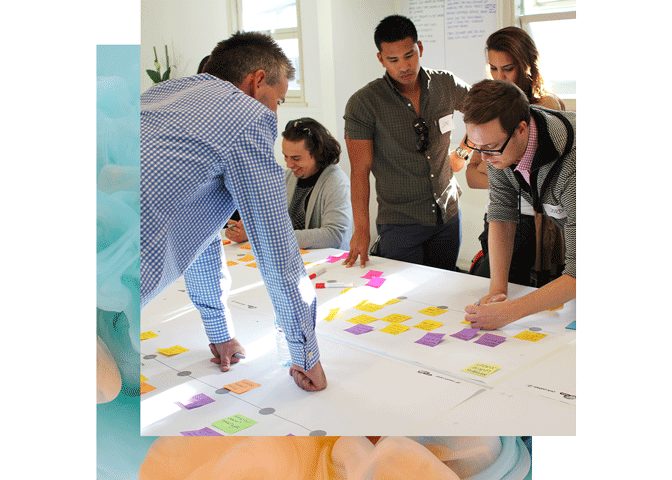
Operational Leaders: Navigate Change & Growth
We help senior operational leaders successfully navigate the changing competitive landscape, identify new growth opportunities and initiate and realise digital transformation projects.
Are your Operations set up to succeed?
We help senior operational leaders successfully navigate the changing competitive landscape, identify new customer opportunities and initiate and realise customer improvement and innovation projects.
We can help you improve your customer experience
Using a combination of customer research, design thinking and commercial rigour, we serve as your guide to delivering the most comprehensive view of the customer you’ve ever had. Together, we work to imagine what's genuinely possible and will create a customer improvement program that differentiates and innovates. We use extensive experience in deeply understanding customers and their needs, then develop prioritised roadmaps that are pragmatic and commercially realistic.
The results we seek with you are human-centred, grounded in your reality– so that in the end, you’ll know exactly what your customers want and what prioritised steps you need to take across your organisation to achieve your goals.
What Operatinal Leaders Gain
Working with us gives you
Comprehensive customer insights that support strategic decision-making
Clear roadmaps that prioritise initiatives and balance ambition with delivery
Design blueprints and user stories that connect strategy with execution
Governance tools to manage transformation and prove its impact
Alignment across teams to accelerate results and sustain change
Results that matter: We’ve helped senior organisational leaders to:
Deliver customer improvement programs that differentiate them in competitive markets
Build leadership alignment around customer-first strategies
Successfully plan, initiate, and realise digital transformation projects grounded in customer insight
The results are human-centred, commercially grounded, and built for lasting impact.
Successfully plan, initiate and realise customer improvement projects.
Operational leaders who want to leverage customer understanding and insight into business growth are faced with numerous challenges: from identifying the right customer-related growth opportunities and getting buy-in from key stakeholders, to developing ambitious, but achievable, solutions as part of a major change strategy.
You need a partner that can help you overcome these challenges and make your customer improvement and transformation goals a reality. That’s what we’re here to do.
How We Support Senior Leaders
Our approach combines customer research, design thinking, and commercial rigour. We guide leaders through:
1.Navigating Changing Landscapes
We provide insights that help leadership teams adapt strategy, unify priorities, and respond effectively to disruption.
2. Building Alignment and Engagement
We equip leaders to align stakeholders and transform around the customer, creating faster, more successful business transformations.
3. Ensuring Transformation Succeeds
We design and deliver initiatives that improve customer relationships, build smarter operations, and accelerate improvements across the business.

Make great customer experience a reality
We listen to your commercial objectives and then collaborate with you to create and design real customer offers that succeed. We then communicate our design blueprints and user stories to your technology and business teams, who produce, launch and operate them
1. Identify promising opportunities
We help you identify the most promising opportunities for your business, products and team
2. Develop clear, actionable strategies
We help you develop ambitious but highly actionable plans to make your business goals a reality.
3. Maximise Loyalty and Retention
We help you develop and execute strategies that will see you keep more of your customers for longer.
Use Cases
Customer Champions
Empower your customer champions with the insights, tools, and support they need to lead initiatives, improve engagement, and build lasting loyalty.
Enterprise Software Build
Guide enterprise software builds with customer insight and design thinking to ensure technology delivers real value for users and the business.
Senior Organisational Leaders
Help senior organisational leaders navigate disruption, align strategy with customer needs, and deliver growth through evidence-based transformation.
AI Strategy Implementation
TTurn AI from ambition into execution. We help you design, pilot, and embed AI strategies that align with business goals, improve efficiency, and deliver measurable ROI.
Operation Leaders
Equip operation leaders with customer insight and practical frameworks to improve performance, streamline delivery, and lift customer outcomes
Local Government
Support local government teams to design citizen-centred services, build community trust, and deliver measurable improvements in service delivery
Meet Damian
As Proto CEO, Damian is responsible for driving our clients growth initiatives. He has a wealth of local and international experience with companies such as Diageo, Fosters and Telstra in senior management roles as well as co-founding Proto 14 years ago and leading over 200+ projects.
Ready to build customer engagement champions in your business?
Book a session with our team to train and empower champions who can lead customer projects, lift loyalty, and deliver measurable growth.






